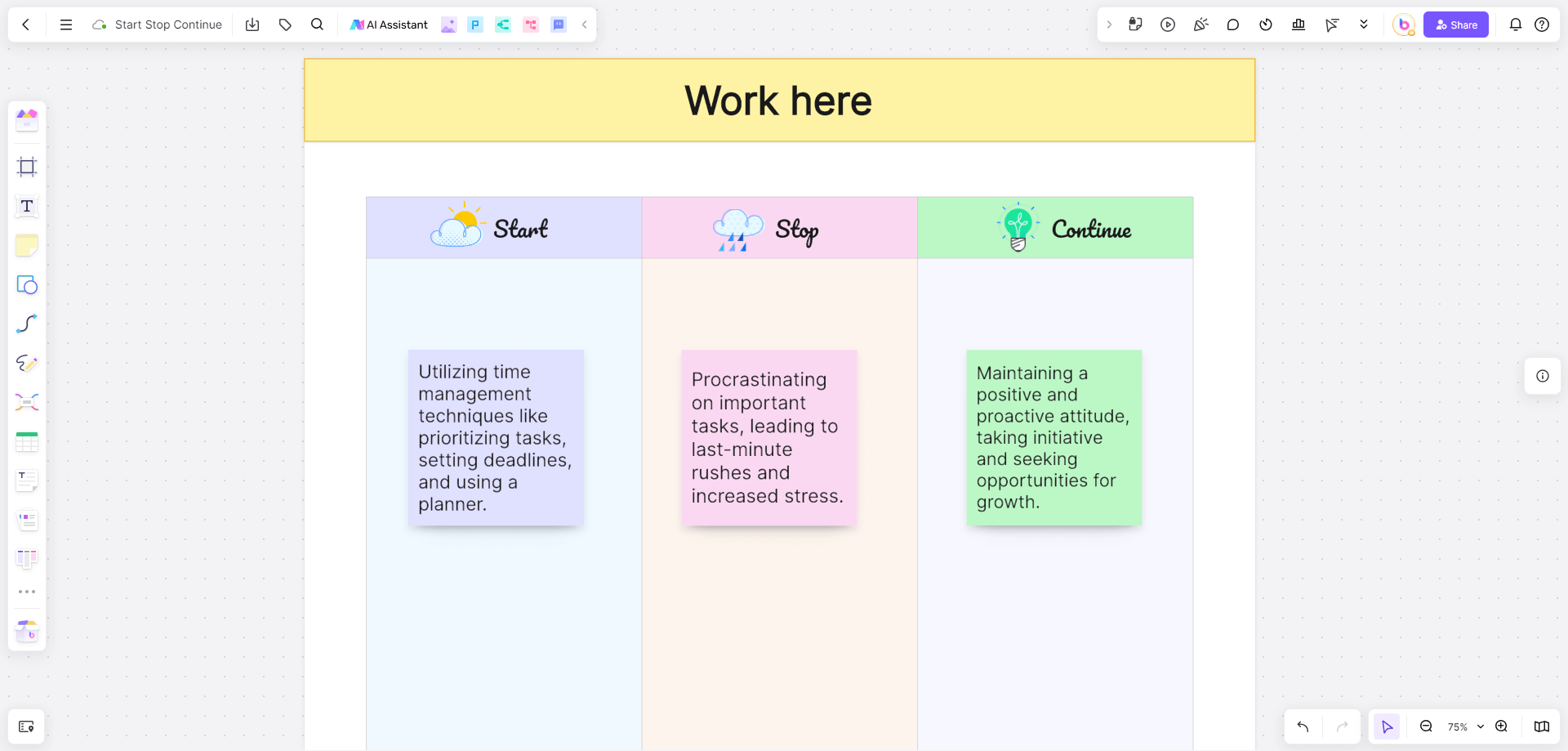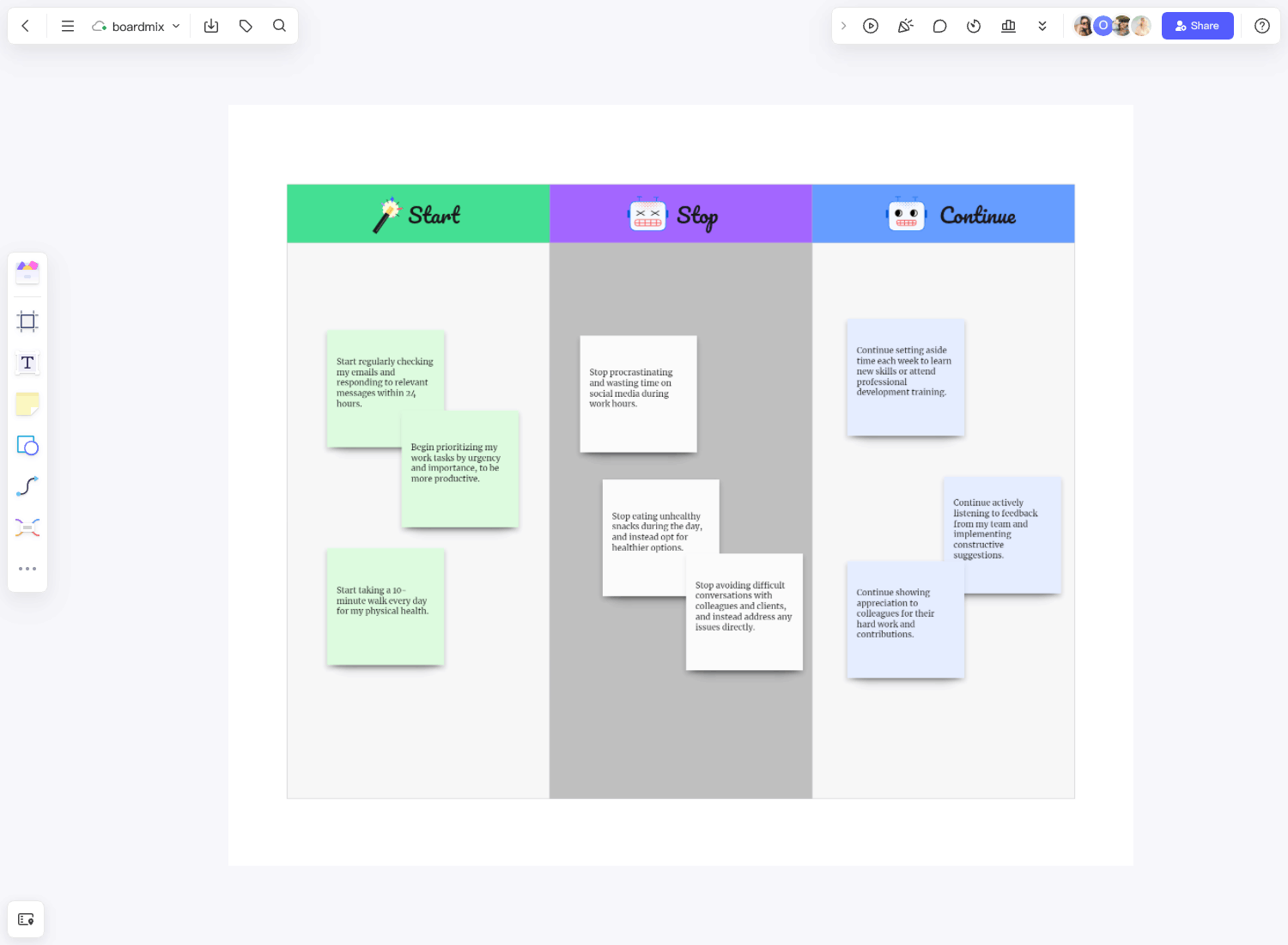The Start Stop Continue (SSC) feedback method offers a structured and straightforward approach to harnessing the power of feedback. By identifying actions to start, stop, and continue, individuals and teams can focus on what truly matters, fostering a culture of growth and transparency. This article delves into the intricacies of the SSC method, providing practical start stop continue examples and tips to help you implement it effectively.
What is the start stop and continue method of feedback?

The Start Stop and Continue (SSC) feedback method is a simple yet powerful tool for gathering constructive feedback and driving improvement. This method encourages individuals or teams to reflect on their actions and categorize them into three areas:
Start: New actions or behaviors that should be initiated.
Stop: Existing actions or behaviors that should be discontinued.
Continue: Current actions or behaviors that are effective and should be maintained.
Start Stop and Continue feedback is popular because it promotes continuous improvement and transparency. By clearly identifying what to start, stop, and continue, this method helps streamline processes, enhance communication, and foster a culture of continuous feedback and development.
Why is Start Stop Continue Popular in Various Fields?

The Start Stop and Continue feedback method is employed across various fields and industries because of its simplicity and effectiveness. Some of the reasons for its popularity include:
Ease of Use: The framework is straightforward, making it easy for anyone to understand and apply without extensive training.
Structured Feedback: It provides a clear structure for giving and receiving feedback, minimizing ambiguity and ensuring actionable insights.
Encourages Participation: It invites input from all team members, fostering a sense of inclusion and collective responsibility.
Focus on Improvement: By categorizing actions into start, stop, and continue, it helps focus efforts on what truly matters for improvement and success.
How Does Start Stop and Continue Promote Continuous Improvement and Transparency?
The Start Stop and Continue method promotes continuous improvement and transparency in several ways:
Regular Feedback Cycles: By incorporating regular feedback sessions, teams can continuously reflect and adjust their actions, fostering a culture of ongoing improvement.
Clarity and Focus: The clear categorization helps focus on specific actions, reducing confusion and ensuring that feedback is actionable.
Open Communication: It encourages open dialogue among team members, enhancing trust and transparency within the team.
Accountability: Clearly defined actions and responsibilities help hold individuals and teams accountable for their improvement efforts.
What are good Stop Continue Start feedback?
To better understand how to implement the Start Stop Continue method, let’s explore six detailed start stop continue examples of Start Stop and Continue feedback categorized for managers, employees, and personal development.
For Managers
Example 1: Team Collaboration

Start: Implementing regular team-building activities to foster a stronger sense of camaraderie and collaboration.
Reason: Team-building activities can help break down silos and improve communication among team members.
Impact: Enhanced team cohesion and a more collaborative work environment.
Stop: Micromanaging team members, allowing them to take ownership and make decisions independently.
Reason: Micromanagement can stifle creativity and reduce job satisfaction.
Impact: Increased autonomy and empowerment, leading to higher morale and productivity.
Continue: Providing regular and constructive feedback to team members, recognizing their achievements and areas for improvement.
Reason: Regular feedback helps employees understand their performance and areas for growth.
Impact: Continuous improvement and motivation among team members.
Example 2: Performance Reviews

Start: Conducting regular one-on-one meetings with employees to discuss their progress, goals, and challenges.
Reason: Regular check-ins can help address issues early and keep employees aligned with their goals.
Impact: Improved employee engagement and performance.
Stop: Focusing solely on performance metrics, considering the employee's overall development and well-being.
Reason: A holistic approach to performance reviews can lead to more meaningful development.
Impact: Better employee satisfaction and retention.
Continue: Providing clear expectations and goals for each employee, ensuring they understand their role and responsibilities.
Reason: Clear expectations help employees focus and prioritize their efforts.
Impact: Enhanced clarity and productivity.
For Employees
Example 1: Communication

Start: Proactively communicating with your manager about your progress, challenges, and ideas.
Reason: Proactive communication helps keep everyone informed and aligned.
Impact: Improved transparency and problem-solving.
Stop: Avoiding difficult conversations or holding back feedback, even if it's constructive criticism.
Reason: Avoiding difficult conversations can lead to unresolved issues.
Impact: More open and honest communication, leading to better team dynamics.
Continue: Being a reliable and responsive team member, contributing actively to projects and meetings.
Reason: Reliability and active participation are crucial for team success.
Impact: Consistent team performance and collaboration.
Example 2: Time Management

Start: Utilizing time management techniques like prioritizing tasks, setting deadlines, and using a planner.
Reason: Effective time management can help prevent last-minute rushes and reduce stress.
Impact: Increased productivity and reduced stress levels.
Stop: Procrastinating on important tasks, leading to last-minute rushes and increased stress.
Reason: Procrastination can lead to poor-quality work and unnecessary stress.
Impact: Better quality of work and improved time management.
Continue: Maintaining a positive and proactive attitude, taking initiative and seeking opportunities for growth.
Reason: A positive attitude and initiative are key to personal and professional growth.
Impact: Enhanced career development and job satisfaction.
For Personal Development
Example 1: Learning and Growth

Start: Actively seeking opportunities to learn new skills and expand your knowledge base.
Reason: Continuous learning is essential for staying competitive and advancing in your career.
Impact: Enhanced skill set and career prospects.
Stop: Avoiding challenges or stepping outside your comfort zone, hindering your growth potential.
Reason: Sticking to comfort zones can limit growth and learning opportunities.
Impact: Broader experiences and accelerated personal growth.
Continue: Maintaining a growth mindset, embracing feedback and using it to improve your performance.
Reason: A growth mindset encourages continuous improvement and resilience.
Impact: Ongoing personal and professional development.
Example 2: Work-Life Balance

Start: Setting boundaries between work and personal life, prioritizing time for relaxation and hobbies.
Reason: Clear boundaries help prevent burnout and maintain overall well-being.
Impact: Improved mental health and productivity.
Stop: Overworking and neglecting your well-being, leading to burnout and decreased productivity.
Reason: Overworking can lead to burnout and negatively affect performance.
Impact: Better work-life balance and sustained productivity.
Continue: Maintaining a healthy lifestyle, including regular exercise, balanced diet, and sufficient sleep.
Reason: A healthy lifestyle supports overall well-being and performance.
Impact: Enhanced energy levels and productivity.
What Should I Start Doing Start Stop Continue Examples?
Boardmix is a tool that can help facilitate a Start Stop and Continue feedback session. Here’s how you can use Boardmix to effectively gather and organize feedback:

Create a Board: Log into your Boardmix account and create a new board specifically for the feedback session.
Design the Board: Divide the board into three sections: Start, Stop, Continue. Use different colors or icons for visual clarity.
Populate the Board: Add sticky notes or cards for each identified action. You can use a template like this:
Start
Action: [Action to be started]
Reason: [Why this action should be started]
Impact: [Expected positive impact of starting this action]
Solution: [How to implement this action]
Stop
Action: [Action to be stopped]
Reason: [Why this action should be stopped]
Impact: [Expected negative impact of continuing this action]
Solution: [How to cease this action]
Continue
Action: [Action to be continued]
Reason: [Why this action should be continued]
Impact: [Positive impact of continuing this action]
Solution: [How to further enhance this action]
Facilitating the Exercise:
Introduction: Explain the purpose of the exercise and how it works.
Brainstorming Session: Encourage participants to brainstorm ideas for each section.
Discussion and Consensus: Discuss each item and its implications. Reach consensus on which actions to start, stop, and continue.
Developing an Action Plan: Assign responsibilities, set deadlines, and establish regular check-ins to monitor progress.
Conclusion

The Start Stop and Continue feedback method has proven to be a valuable tool for continuous improvement and personal development. As organizations and individuals strive for growth, the use of structured feedback methods like Start Stop and Continue will remain essential.
The future of stop continue start feedback looks promising, with increasing adoption across various fields. Its simplicity, flexibility, and effectiveness make it a timeless tool for fostering improvement and transparency.
In conclusion, the stop continue start feedback method is a powerful and versatile tool that can drive significant improvements in various aspects of professional and personal life. By understanding its principles and effectively implementing it, you can unlock new levels of success and development.









